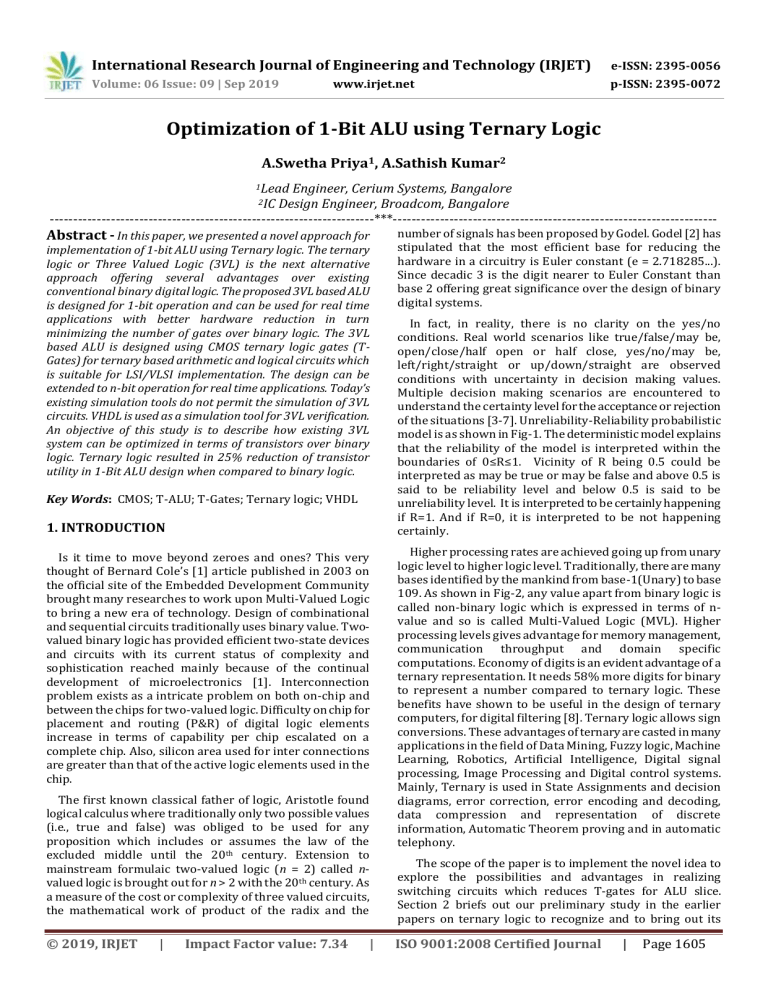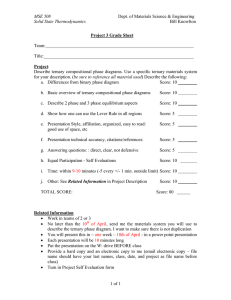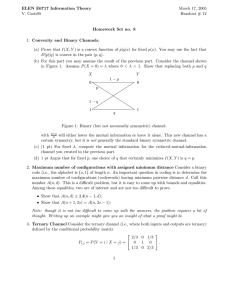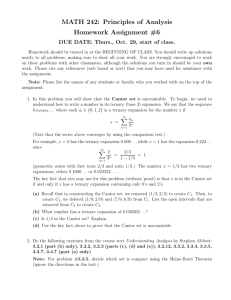IRJET-Optimization of 1-Bit ALU using Ternary Logic
advertisement

International Research Journal of Engineering and Technology (IRJET)
e-ISSN: 2395-0056
Volume: 06 Issue: 09 | Sep 2019
p-ISSN: 2395-0072
www.irjet.net
Optimization of 1-Bit ALU using Ternary Logic
A.Swetha Priya1, A.Sathish Kumar2
1Lead
Engineer, Cerium Systems, Bangalore
Design Engineer, Broadcom, Bangalore
---------------------------------------------------------------------***--------------------------------------------------------------------2IC
Abstract - In this paper, we presented a novel approach for
implementation of 1-bit ALU using Ternary logic. The ternary
logic or Three Valued Logic (3VL) is the next alternative
approach offering several advantages over existing
conventional binary digital logic. The proposed 3VL based ALU
is designed for 1-bit operation and can be used for real time
applications with better hardware reduction in turn
minimizing the number of gates over binary logic. The 3VL
based ALU is designed using CMOS ternary logic gates (TGates) for ternary based arithmetic and logical circuits which
is suitable for LSI/VLSI implementation. The design can be
extended to n-bit operation for real time applications. Today’s
existing simulation tools do not permit the simulation of 3VL
circuits. VHDL is used as a simulation tool for 3VL verification.
An objective of this study is to describe how existing 3VL
system can be optimized in terms of transistors over binary
logic. Ternary logic resulted in 25% reduction of transistor
utility in 1-Bit ALU design when compared to binary logic.
Key Words: CMOS; T-ALU; T-Gates; Ternary logic; VHDL
1. INTRODUCTION
Is it time to move beyond zeroes and ones? This very
thought of Bernard Cole’s [1] article published in 2003 on
the official site of the Embedded Development Community
brought many researches to work upon Multi-Valued Logic
to bring a new era of technology. Design of combinational
and sequential circuits traditionally uses binary value. Twovalued binary logic has provided efficient two-state devices
and circuits with its current status of complexity and
sophistication reached mainly because of the continual
development of microelectronics [1]. Interconnection
problem exists as a intricate problem on both on-chip and
between the chips for two-valued logic. Difficulty on chip for
placement and routing (P&R) of digital logic elements
increase in terms of capability per chip escalated on a
complete chip. Also, silicon area used for inter connections
are greater than that of the active logic elements used in the
chip.
The first known classical father of logic, Aristotle found
logical calculus where traditionally only two possible values
(i.e., true and false) was obliged to be used for any
proposition which includes or assumes the law of the
excluded middle until the 20th century. Extension to
mainstream formulaic two-valued logic (n = 2) called nvalued logic is brought out for n > 2 with the 20th century. As
a measure of the cost or complexity of three valued circuits,
the mathematical work of product of the radix and the
© 2019, IRJET
|
Impact Factor value: 7.34
|
number of signals has been proposed by Godel. Godel [2] has
stipulated that the most efficient base for reducing the
hardware in a circuitry is Euler constant (e = 2.718285...).
Since decadic 3 is the digit nearer to Euler Constant than
base 2 offering great significance over the design of binary
digital systems.
In fact, in reality, there is no clarity on the yes/no
conditions. Real world scenarios like true/false/may be,
open/close/half open or half close, yes/no/may be,
left/right/straight or up/down/straight are observed
conditions with uncertainty in decision making values.
Multiple decision making scenarios are encountered to
understand the certainty level for the acceptance or rejection
of the situations [3-7]. Unreliability-Reliability probabilistic
model is as shown in Fig-1. The deterministic model explains
that the reliability of the model is interpreted within the
boundaries of 0≤R≤1. Vicinity of R being 0.5 could be
interpreted as may be true or may be false and above 0.5 is
said to be reliability level and below 0.5 is said to be
unreliability level. It is interpreted to be certainly happening
if R=1. And if R=0, it is interpreted to be not happening
certainly.
Higher processing rates are achieved going up from unary
logic level to higher logic level. Traditionally, there are many
bases identified by the mankind from base-1(Unary) to base
109. As shown in Fig-2, any value apart from binary logic is
called non-binary logic which is expressed in terms of nvalue and so is called Multi-Valued Logic (MVL). Higher
processing levels gives advantage for memory management,
communication throughput and domain specific
computations. Economy of digits is an evident advantage of a
ternary representation. It needs 58% more digits for binary
to represent a number compared to ternary logic. These
benefits have shown to be useful in the design of ternary
computers, for digital filtering [8]. Ternary logic allows sign
conversions. These advantages of ternary are casted in many
applications in the field of Data Mining, Fuzzy logic, Machine
Learning, Robotics, Artificial Intelligence, Digital signal
processing, Image Processing and Digital control systems.
Mainly, Ternary is used in State Assignments and decision
diagrams, error correction, error encoding and decoding,
data compression and representation of discrete
information, Automatic Theorem proving and in automatic
telephony.
The scope of the paper is to implement the novel idea to
explore the possibilities and advantages in realizing
switching circuits which reduces T-gates for ALU slice.
Section 2 briefs out our preliminary study in the earlier
papers on ternary logic to recognize and to bring out its
ISO 9001:2008 Certified Journal
|
Page 1605
International Research Journal of Engineering and Technology (IRJET)
e-ISSN: 2395-0056
Volume: 06 Issue: 09 | Sep 2019
p-ISSN: 2395-0072
www.irjet.net
importance. Section 3 gives the basic study of ternary logic
gates. In Section 4, gives the ternary 1-bit ALU operation. The
simulation of the ALU and its results is described in section 5.
Section 6 shows the advantages of ternary over binary and
the conclusion is given in Section 7.
For X, Y, Z L, there exists an equivalence (=) operation,
such that X = X, If X= Y, then Y = X, If X=Y & Y=Z, then X = Z.
Clearly (L, +, ) is a distributive lattice with zero
element(0 or ) and universal element(2 or ). Thus X, Y,
Z L [1-5]:
Idempotent Law : X+X = X
X X = X
(2)
Commutative Law: X+Y = Y+X
X Y = Y X
(3)
Associative Law : (X+Y) + Z = X+(Y+Z)
(4)
X (Y Z) = (X Y) Z
(5)
Absorption Law : X+ X Y =X
X (X+Y) = X
(6)
Distributive Law : X+Y Z = (X+Y) (X+Z)
(7)
X (Y+Z) = X Y+X Z
(8)
To implement three valued logic function, unary variables
are primarily selected through a Ternary decoder approach
as shown in the Fig-3, which converts all the unary variables
to suitable conditions of ternary variables to formulate a
ternary function.
Fig -1: Implementation of ternary function
Fig
-3:
Implementation of ternary function
a
Literal is denoted by X i i , where a i = , , ,
is defined as given Table -1.
,
and
Table -1: Function Table of Unary Functions
Fig -2: Levels of Switching Algebra and its extension to Nvalued logic
2. TERNARY SWITCHING ALGEBRA
For a ternary switching algebra, a suitable set of
operations ought to be selected from the set of all possible
variables [1-5]. Let a system be L whose elements called
propositions or statements are valued in the set { , , }. If
X is a proposition, the value of X can be seen as a mapping
V : L , , such that
(1)
Objective of using general variables , , is to consider
any type of present or future device technology and also for
positive or negative logic representation. Ternary logic level
‘ ’ generally corresponds to logic-0 also called low voltage
which is well defined in binary, ‘ ’ corresponds to an
intermediate or uncertainty stage and ‘ ’ corresponds to
logic-1 also called high voltage which is well defined in
binary. The intermediate state ‘ ’ can be metaphorically
thought of partially true and partially false condition.
2.1 Basic Laws of Ternary Logic
© 2019, IRJET
|
Impact Factor value: 7.34
|
Some expressions useful in ternary logic are:
Where i = ,
(9)
(10)
(11)
X X X X
X X X X
(12)
X X X
(13)
X X X
X X X
(14)
X+ =X
X• =
(15)
X+ =
X• =X
(16)
Universally formulated De Morgan's Theorem [5] also holds
good for ternary logic. Three types of inverters are used to
implement De Morgan’s theorem.
X X X X
&
(17)
(18)
(19)
X Y X Y
(20)
X Y X Y
(21)
X Y X Y
(22)
X
X
X Y X Y
The canonical Sum of Product (SOP) and Product of Sum
(POS) Product of Sum (POS) can be written as
X
X
Y
Y
X Y
X Y
ISO 9001:2008 Certified Journal
|
Page 1606
International Research Journal of Engineering and Technology (IRJET)
e-ISSN: 2395-0056
Volume: 06 Issue: 09 | Sep 2019
p-ISSN: 2395-0072
www.irjet.net
f(xl,x2, ..., xn) = • g(xl,x2 ..... xn) + • h(x1,x2, ....,xn)
i.e., f = g + • h
(23)
f(xl,x2, ..., xn) =( • g(xl,x2 ..... xn) ) • ( + h(x1,x2, ....,xn))
i.e., f = g • ( + h )
(24)
3. Ternary Gate Design
The basic building block of ternary decoder is a general
ternary inverter (GTI). A GTI is takes a unary operator with
one input X and produces 3 possible outputs. The
implementation of ternary inverter requires three types of
inverters namely negative ternary inverter (NTI), simple
ternary inverter (STI) and positive ternary inverter (PTI)
forming an operator set that is complete in logic sense[6-9].
These T-inverter acts as a basic fundamental element for
constructing ternary AND/NAND (T-AND/NAND), ternary
OR/NOR( T-OR/NOR) and soon. Table -2 summarized the
functioning of three types of ternary Inverters.
STI X X
Logic Sum or TOR and Logic Product or TAND:
X1 X2 … Xn =MAX ( X1, X2,…, Xn )
(27)
X1 X2 … Xn =MIN ( X1, X2,…, Xn )
(28)
Similarly, TNAND and TNOR is
X1 X2 … Xn
=MIN ( X1 X2 … Xn )
(29)
(25)
X1 X2 .. Xn =MAX ( X1 X2 .. Xn )
(26)
In Voltage mode, logic state are specified in terms of
distinct voltage levels i.e., V1, V2, V3....Vn. Voltage modes are
further divided into balance modes and unbalanced modes
[11]. Balanced modes are the logic states defined in terms of
distinct voltage levels i.e., +V = 1(logic high), Ground =
0(intermediate state) & -V = -1(logic low). Balanced mode is
more efficiently identified as standard in the industry. And
based on the “N” value defined, we have these voltage levels
like 1,0,-1 for ternary logic. Unbalanced modes are the logic
states defined in terms of voltage levels i.,e V = 2(logic high),
V/2 = 1(intermediate logic) & Ground = 0(logic
low),(equivalently it is V = γ, V/2 = β & Ground = α or V =1,
V/2 = z & Ground = 0). It uses non-negative numbers for
representation. In Current mode [12], logic states are
specified in terms of multiples of reference current states ie.,
xI1,xI2, xI3 .... xIn where x is reference current.
where i takes the value of for PTI and for the NTI
operator. The minus sign represents arithmetic subtraction.
Symbols of Ternary Inverters are given in Fig-4.
Fig -4: Basic Ternary logic gates
Table -2: Function Table For Ternary Inverter
(30)
4. Design of 1-Bit Ternary ALU
Ternary OR (TOR) and Ternary AND (TAND) represent
ORing (+) and ANDing (.) respectively on L in Ternary
terminology. These gates are as shown in Fig-4. and basically
it requires two or more multiple input operators [1-6].
Functioning of these gates are represented by following
equations and are tabulated as given in Table -3.
Binary logic is restricted to only two states ‘0’ and ‘1’
whereas three-valued logics have three truth values. And so
Ternary logic is also called three-valued or trivalent logic
and is abbreviated to 3VL as it has three distinct voltage
levels. 3VL, in general a multi-valued logic(MVL) is
implemented in two modes i.e. current mode and voltage
mode[10].
ALU (Arithmetic Logic Unit) which is the central execution
unit of a CPU is a combinatorial circuit performing arithmetic
and logical operations and its complexity keeps varying [13].
Ternary ALU (T-ALU) slice has been designed for the 1-bit
ternary operations. This can be extended for n-bit operations
also and can also be implemented by cascading smaller basic
n/2 ALU slices as well. This proposed ALU is designed to
have CMOS logic T-Gates for ternary arithmetic & logic
operations which is suitable for LSI/VLSI implementation.
The design of ALU slice is shown in Fig-5 and works as per
the functional Table -4. Depending on the selection line (S)
and the bits X & Y, the corresponding operations will be
performed by T-ALU. Arithmetic operations are as given in
the Table -5.
Table -3: Truth Table For Basic Gates
© 2019, IRJET
|
Impact Factor value: 7.34
|
ISO 9001:2008 Certified Journal
|
Page 1607
International Research Journal of Engineering and Technology (IRJET)
e-ISSN: 2395-0056
Volume: 06 Issue: 09 | Sep 2019
p-ISSN: 2395-0072
www.irjet.net
A
α
α
α
β
β
β
γ
γ
γ
B
α
β
γ
α
β
γ
α
β
γ
Operation
Addition
Subtraction
Multiplication
Comparator
-
Operation
TAND
TOR
Ex-OR
STNAND
PTNAND
NTNAND
STNOR
PTNOR
NTNOR
Table – 6: 9- State Logic System[10]
Fig -5: Block diagram of 1-Bit T- ALU Slice
5. Simulator for T-ALU
The performance evaluation of 3VL circuits is dealt with
the use of Very High-Speed Integrated Circuit Hardware
Description Language (VHDL) as a logic simulator[10-14]
which is used to model, simulate and describe tristate valued
signals of a ternary systems with true, false and with a third
transparent high impedance state. An effective way out to
connect different distinct logic outputs with characteristics of
high impedance state (Z) to a single input allowing the
remaining outputs to operate in the normal binary sense can
be done with VHDL. Commonly, the concept is used memory
banks of computers and other similar devices to a common
data bus where a large number of devices can communicate
over the same channel ensuring only one to be enabled at a
time.
Table -4: Functional Table of Logical Operations
Symbols
U
Values
Uninitialized
X
0
1
Z
Unknown
Logic 0
Logic 1
High
Impedance
Weak
unknown
Weak zero
Weak one
Don’t care
W
L
H
-
Fig -6: Waveforms of (a) Two-valued logic and (b)
Three-valued logic
6. Total Number of Transistor Calculation
For binary based two input AND & OR gate requires 4
transistors and for three input requires 6 transistors. The
Binary 1-bit ALU can give only 4 different combinations of
The proposed VHDL simulator is developed with
technology dependent package called 9-state StdLogic_1164
package [14] whose levels are as listed in Table -6 which is
used to synthesize and to verify the performance of ternary
logic circuits. This VHDL permits to describe the circuits like
TTL, CMOS, GaAs, NMOS, PMOS and ECL[15,16] based on the
design implemented for the examination and requires a
change in package development to support the design. To
demonstrate the use of VHDL as a ternary logic simulator, we
have used Logic Low to represent α or equivalently 0V, High
impendence Z to represent β or equivalently 1V and Logic
high to represent γ or equivalently 2V as shown in Fig-6. The
simulation result of 1-bit T-ALU is as shown in Fig-7.
Table -5: Functional Table of T-ALU
Bits
© 2019, IRJET
For S=0
|
For S=1
Impact Factor value: 7.34
|
operations like addition, subtraction, multiplication,
comparator operation and a final multiplexer to select either
one of the operation.
6.1 Binary Logic
For addition operation, totally 6 gates are used.
No. of Inverters are 2
No. of 2 input AND & OR Gates are 4
2*2 = 4
4*4 = 16
----------------------Total no. of transistors with Inverters 20 transistors
For subtraction operation, totally 3 gates are used.
No. of Inverters is 1
1*2 = 2
No. of 2 input AND is 1
1*4 = 4
ISO 9001:2008 Certified Journal
|
Page 1608
International Research Journal of Engineering and Technology (IRJET)
e-ISSN: 2395-0056
Volume: 06 Issue: 09 | Sep 2019
p-ISSN: 2395-0072
www.irjet.net
No. of 2 input XOR is 1
1*8 = 8
----------------------Total no. of transistors with Inverters 14 transistors
For multiplication operation, totally 7 gates are used.
No. of Inverters is 2
2*2 = 4
No. of 2 input AND are 4
4*4 = 16
No. of 2 input OR is 1
1*4 = 4
----------------------Total no. of transistors with Inverters 24 transistors
For comparator operation, totally 5 gates are used.
No. of Inverters is 2
2*2 = 4
No. of 2 input AND are 3
3*4 = 12
----------------------Total no. of transistors with Inverters 16 transistors
For multiplexer operation, totally 9 gates are used.
No. of Inverters are 4
4*2 = 8
No. of 3 input AND are 4
4*4 = 16
No. of 4 input OR is 1
1*10 = 10
----------------------Total no. of transistors with Inverters 34 transistors
Other supporting inverters are 5 which would come totally
to 118 transistors.
6.2 Ternary Logic
For ternary based two input TAND and TOR gate requires 4
transistors and for three input requires 6 transistors.
For Addition (uses T- Half Adder)
4*4 = 16
For Subtraction (uses T- Half subtraction) 4*4 = 16
For Multiplication (uses T- gates)
4*4 = 16
For comparator (uses T-gates)
6*4 = 24
For multiplexer (uses T-gates)
4*4 = 16
----------------------Total no. of transistors with Inverters 88 transistors
Table -7: Ternary and Binary Logic Transistor Count
Comparison for 1-Bit ALU
Table -8: Percentage of Transistor Savings For1-Bit ALU
Total Number of
Transistors
Without Inverters
With Inverters
No. of wires
7. Conclusion
In this paper, we developed a ALU using ternary logic with
optimum hardware circuitry when compared to binary logic.
A scheme based on improved T-gate with formulated design
of ALU and also simulation of 1-bit ALU slice is described in
this paper. An optimization is performed to compared
ternary against the binary to exhibit significance of circuit
reduction in complexity, in turn reflecting in low static
power consumption due to reduced hardware. Also speed of
operation increases as the hardware overhead reduces in
non-binary systems compared to binary systems. Moreover,
proposed ALU can be easily made to implement several
different functions with addition and/or modification in
design and selection logic and can be made as realisable
system to be incorporated as processing unit in ternary
microprocessors. It will reduce the manufacturing cost and
complexity and decrease the number of elements required to
realize a given ternary function. This Ternary logic helped in
about 25% reduction of hardware required in ALU design
when compared to binary logic.
The VHDL simulator has been used to perform both
synthesis and verification of Ternary logic on designs with a
defined StdLogic_1164 package. To develop Ternary circuits
and to verify their performance, tools for digital simulations
are necessary to be developed. For layout generation and
extraction corresponding software tools are not yet
developed by industry. Presently it can be done manually for
which mathematical foundation has been completed in this
project. Further work may be carried out by larger ALU with
the concept of signal co-ordination. Major advantage sought
and achieved is reduction in gate count using Ternary logic.
REFERENCES
Percentage (%)
Saving
19%
25%
18.1%
The total number of transistors comparison between the
Ternary and Binary Logic for both 1-bit and 2-bit ALU are
given in Table -7. Ternary Logic has showed that fewer
numbers of transistors are required to design the ALU when
compared to binary logic which as shown in Table -8.
Fig -7: The simulation result of 1-bit T-ALU
A.Sathish Kumar and A.Swetha Priya, “Minimization Of
Ternary Combinational Circuits – A Survey”,
International Journal Of Engineering Science and
Technology (IJEST 2010), Vol. 02(8), ISSN:0975-5462,
pp. 3576-3589, Aug. 2010.
[2] A. Sathish Kumar and A. Swetha Priya, “Modeling Of
Combinational Circuits Based On Ternary Multiplexer
Using VHDL”, International Journal On Computer
Science and Engineering (IJCSE 2010), Vol. 02, No. 05,
ISSN:0975-3397, pp.1777-1791, Aug. 2010.
[3] A.Sathish Kumar and A.Swetha Priya, “Modeling of
Sequential Circuits Based On 3VL Flip-flops Using
VHDL”, International Journal of Computer Information
Systems (IJCIS 2010), Vol 1, Issue 5, ISSN 2229-5208, pp
38-47,Dec.2010.
© 2019, IRJET
ISO 9001:2008 Certified Journal
|
Impact Factor value: 7.34
[1]
|
|
Page 1609
[4]
[5]
[6]
[7]
[8]
[9]
[10]
[11]
[12]
[13]
[14]
[15]
[16]
International Research Journal of Engineering and Technology (IRJET)
e-ISSN: 2395-0056
Volume: 06 Issue: 09 | Sep 2019
p-ISSN: 2395-0072
www.irjet.net
A.Sathish Kumar and A.Swetha Priya, “TDD Realization
For Minimization For Combinational Circuitry”,
International Journal of Computer Information Systems
(IJCIS 2010), Vol 1, Issue 4, ISSN 2229-5208, pp 7-15,
Nov. 2010.
M.Yoeli and G. Rosenfeld, “Logical Design of Ternary
Switching Circuits”, IEEE Transactions on Electronic
Computers, Vol.EC-14, Issue.1, Feb.1965, pp.19-29.
Raymond E. Miller, ”Switching Theory, Vol I”,John Wiley
& Sons, 1966.
K.S.Gorde
http://www.terna.org/enewsletter/AprJun2010/VLSI.pdf (Terna Engineering College)
Robert L. Herrmann, “Selection and Implementation of a
Ternary Switching Algebra”, Spring Joint Computer
Conference, 1968, pp.283-290.
H.T. Mouftah, “A Study On The Implementation Of
Three-valued Logic”, University of Toronto, Toronto,
Ontario, Canada, pp.123-126.
A. P. Dhande and V. T. Ingole, “Design and
Implementation of 2 Bit Ternary ALU Slice”, 3rd
International Conference: Sciences of Electronic (SETIT
2005), IEEE Transc., Mar. 2005, pp.1-11.
WM El-Medany, MR Hussain, “FPGA-Based Advanced
Real Traffic Light Controller System Design”, IEEE
International Workshop on Intelligent Data Acquisition
and Advanced Computing Systems: Technology and
Applications, Dortmund, Germany, Sep.2007.
Vikram Banerjee, Mrinal Kanti Mandal and DR Anirudha
Ghosal, “Automated Traffic Signal controller”,
Electronics For You, Project Ideas, Nov.2002. Available
as:
http://www.electronicsforu.com
/efylinux/circuit/nov2002/traffic.pdf
C. Rozon, “On the Use of VHDL as a Multi-Valued Logic
Simulator”, 26th International Symposium on MultipleValued Logic (ISMVL '96), IEEE, 1996, pp.110-115.
K. C. Smith. (1981): The Prospects for Multivalued Logic:
A Technology and Applications View, IEEE Transactions
on Computers, Vol. C-30, Issue.9, pp.619-634.
S.L.Hurst. (1984): Multivalued logic - Its status and its
future, IEEE Trans .on Computers, vol. C-33, pp. 11601179.
C. Rozon, “On the Use of VHDL as a Multi-Valued Logic
Simulator”, 26th International Symposium on MultipleValued Logic (ISMVL '96), IEEE, 1996, pp.110-115
© 2019, IRJET
|
Impact Factor value: 7.34
|
ISO 9001:2008 Certified Journal
|
Page 1610


![VARIABLE, OPERATOR AND EXPRESSION [SET – 1]](http://s2.studylib.net/store/data/017977543_1-63cdff75b6f4ecbff2fecef218806221-300x300.png)

